Delightful Mini Lemon Bundt Cakes with a Lemon Glaze. This recipe uses both lemon juice and lemon zest in both the cake and glaze for that extra citrusy flavour!
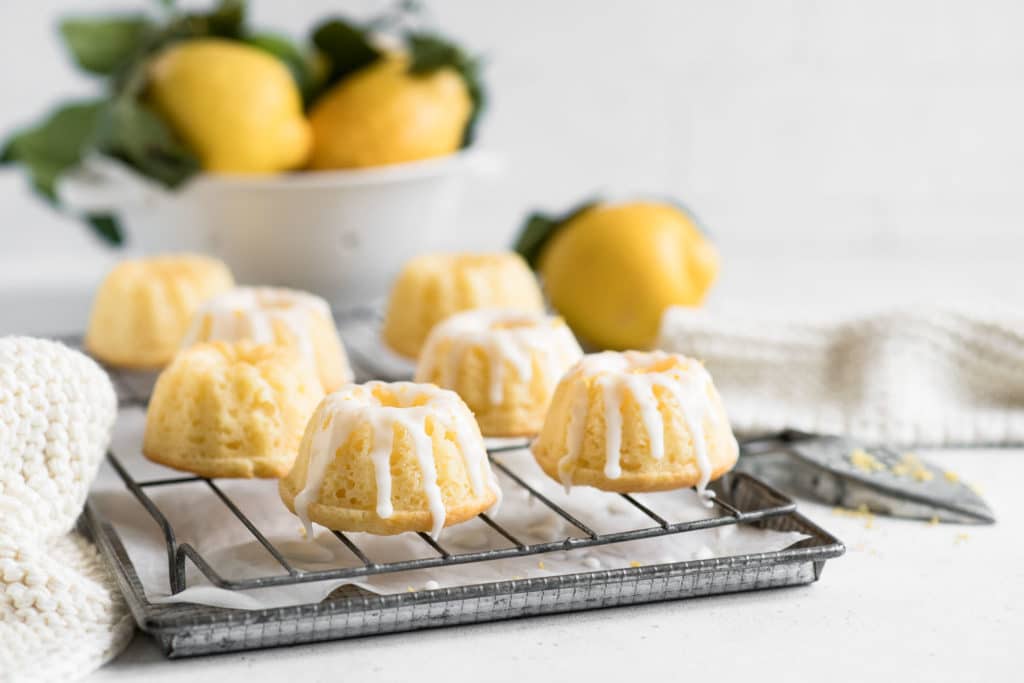
Lemon Bundt Cake Recipe
Spring has finally arrived in Zurich and nothing cheers up the soul like the yellow sunshine of lemons, even though they are technically at their peak in the late winter months.
My favourite cake using lemons is a Gluten-Free Lemon Cake which uses whole lemons in the recipe.
But for something a bit different, and a bit more dainty, these Mini Lemon Bundt Cakes will bring a smile to anyone’s face.
Lemon Glaze
Nothing transforms a cake like a drizzle of glaze on top. These Mini Lemon Bundt Cakes are topped with a tangy lemon glaze which perfectly offsets the sweetness of the cake.
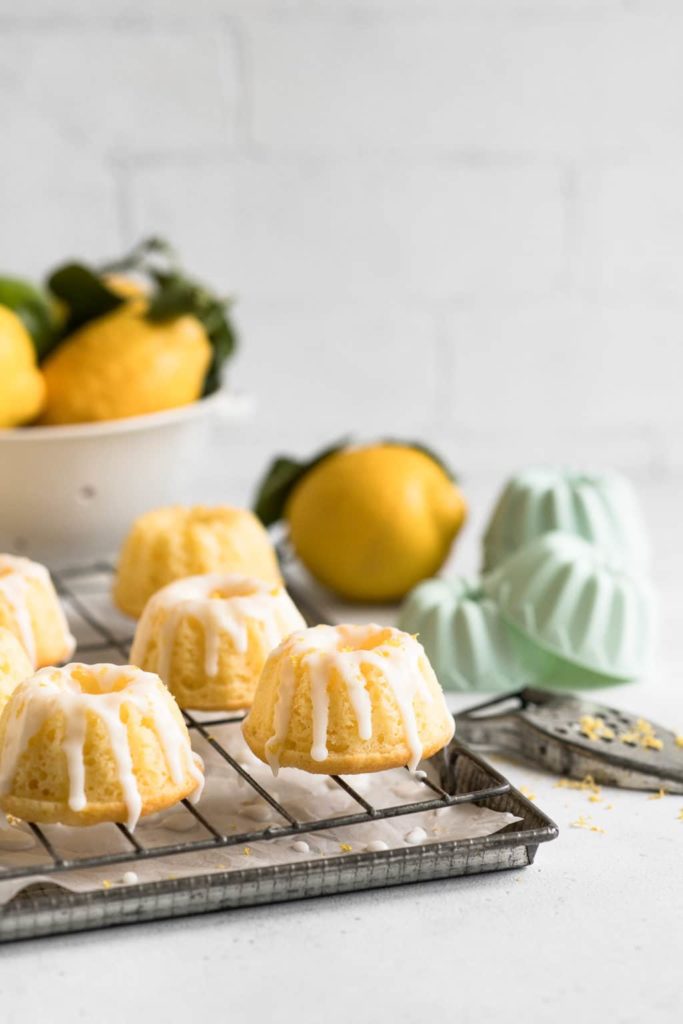
Silicon Bakeware
For the most part, I use traditional metal pans (non-stick and otherwise) for baking. This is mostly because I have been collecting bakeware for as long as I can remember, i.e. before silicon bakeware came into fashion, plus I inherited a small collection of bakeware from when my parents sold their bakery.
I have experimented with silicon bakeware now and then. They work excellently when making Cannelés, but not so much when making Madeleines.
What I find with silicon bakeware is that the outside of the cake never browns and caramelises like those baked in metal molds, and this totally makes sense because silicon conducts heat very differently to metal.
When to Use Silicon Bakeware
I find that silicon bakeware is best in the following situations:
- When making small cakes like muffins.
- When making cakes using intricate molds, like bundt cakes.
For this recipe, I was gifted a set of mini silicon bundt pans to try. Given my experience with silicon bakeware, I knew that silicon molds would be great for making mini bundt cakes because:
- Mini bundt cakes can be difficult to extract from traditional metal molds, even if they have a non-stick coating.
- Mini silicon bundt pans are much easier to clean because you can invert them to easily remove any cake residue from the nooks and crannies.
- Although the mini bundt cakes are not nicely browned on the outside, a glaze or frosting will cover most of the cakes and will even taste nicer against the soft cakes.
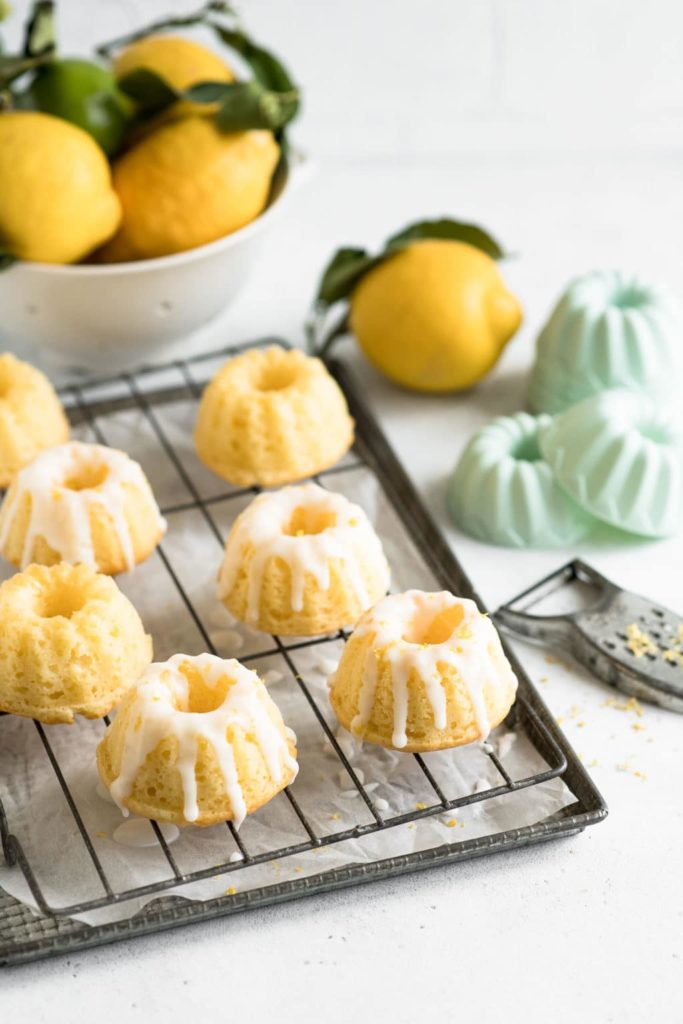
How to Make Lemon Bundt Cakes
This recipe for Lemon Bundt Cake follows the traditional method for making most cakes.
First, cream the butter, sugar and lemon zest together until the mixture is light and fluffy.
Add the eggs, one at a time, followed by a spoonful of the dry ingredients to stop the mixture from curdling.
Once all of the eggs have been added, beat in the remaining dry ingredients, together with the lemon juice and milk.
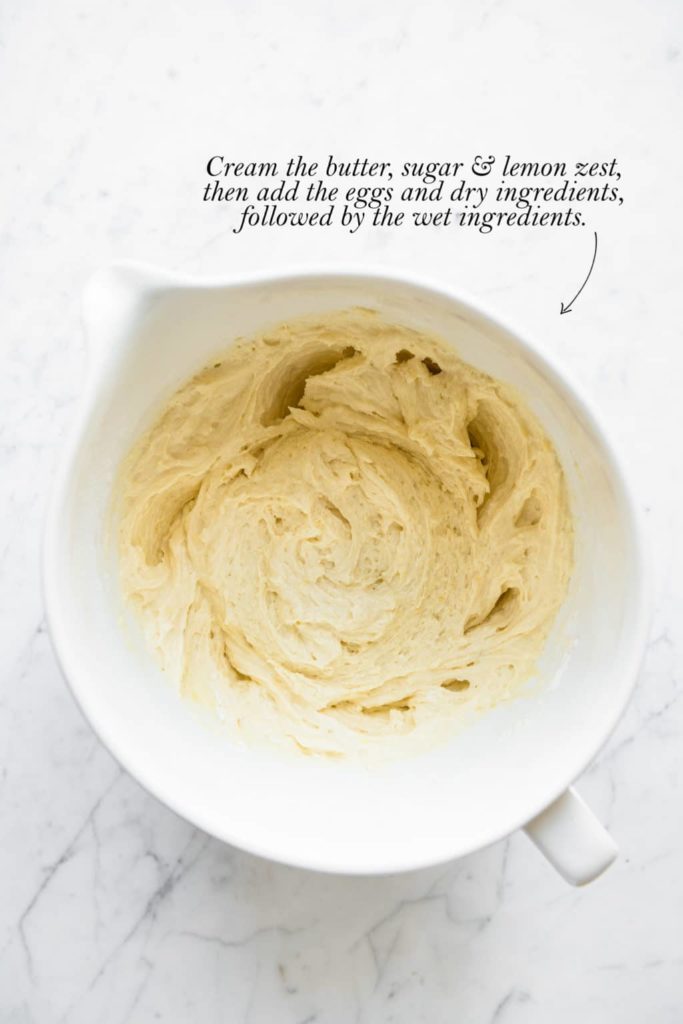
Whether you are using silicon or metal bundt pans, I recommend a light coating of non-stick baking spray, followed by a light dusting of flour.
Place the individual bundt pans onto a metal baking tray, and fill the molds evenly with the batter, making sure that you leave a 1 cm (1/2 inch) border from the top.
Bake the cakes until they are lightly golden (about 12 to 15 minutes), and let the cakes settle in the bundt pans for about 5 minutes before turning them out on a wire rack to cool completely.
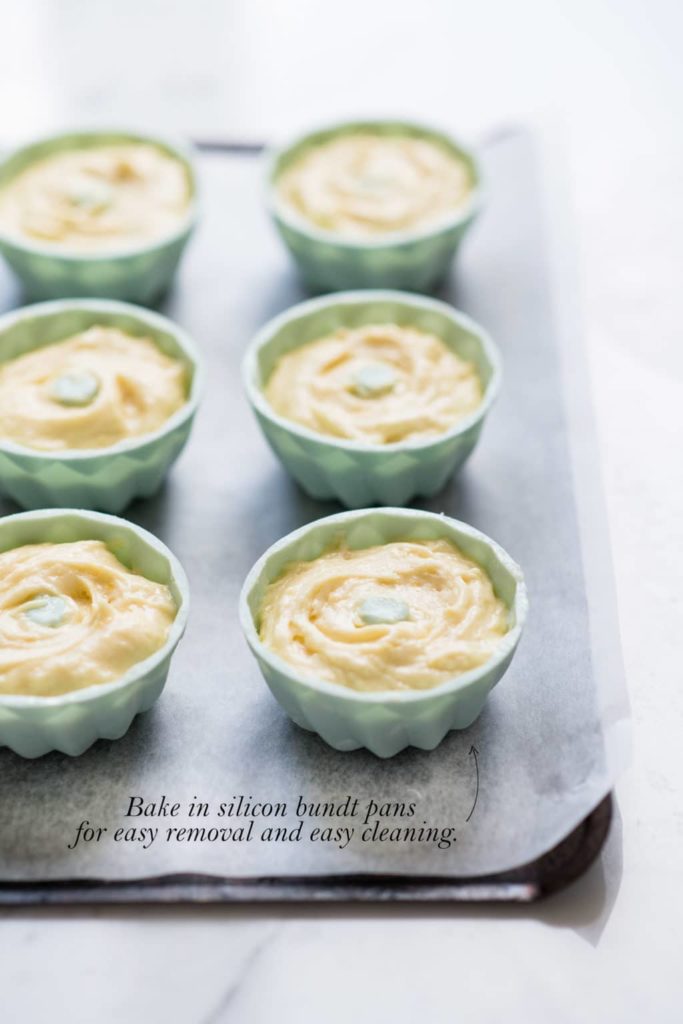
More Lemon Cake Recipes
If you are looking for more lemon cake recipes, you might also like:
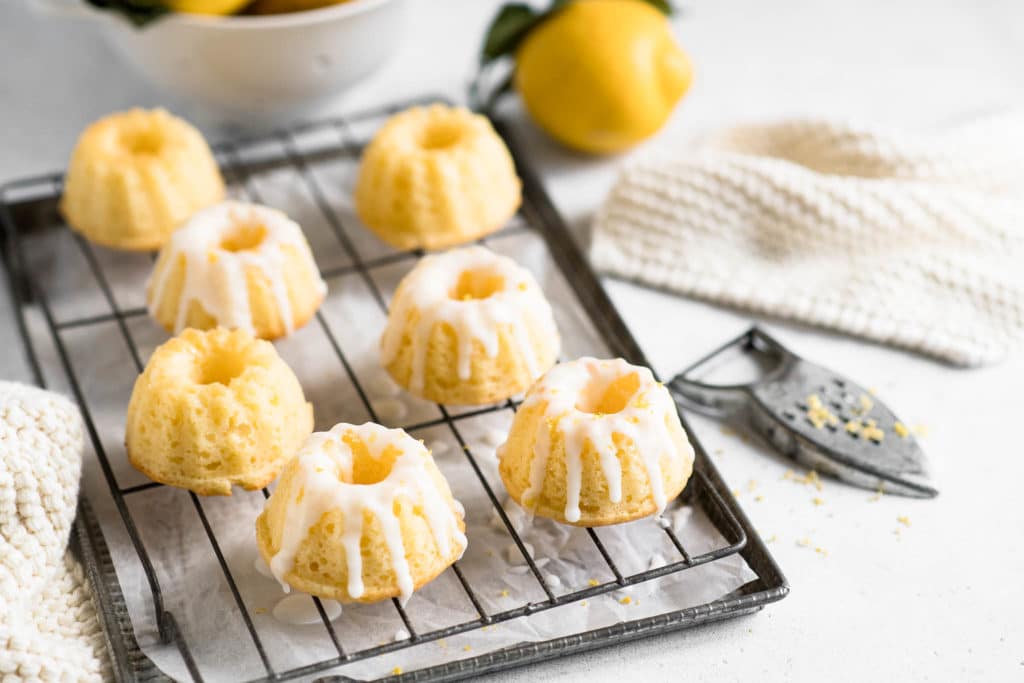

Mini Lemon Bundt Cakes
- Prep Time: 15 mins
- Cook Time: 15 mins
- Total Time: 30 minutes
- Yield: 12 to 15 cakes
- Category: Cakes
- Method: Bake
- Cuisine: British
Delightful Mini Lemon Bundt Cakes with a Lemon Glaze. This recipe uses both lemon juice and lemon zest in both the cake and glaze for that extra citrusy flavour!
Ingredients
For the lemon bundt cakes
- 225 g unsalted butter, softened
- 225 g caster sugar (superfine sugar)
- zest of 2 lemons
- 275 g plain flour (all-purpose flour)
- 3 teaspoons baking powder
- pinch of fine salt
- 4 eggs
- 2 tablespoons lemon juice
- 2 tablespoons milk
- non-stick baking spray
For the lemon glaze
- 225 g (1 2/3 cup) icing sugar (powdered sugar)
- 1–2 tablespoons lemon juice
- zest of 1 lemon
Instructions
For the lemon bundt cakes
- Preheat the oven to 180°C (350°F) (without fan).
- Grease and lightly flour 12 to 15 mini bundt pans (metal or silicon). (Please see Kitchen Notes)
- Place the mini bundt pans onto a baking tray.
- Cream the butter, sugar and lemon zest together until light and fluffy. I like to do this using an electric stand mixer with the flat-paddle attachment.
- Measure the flour, baking powder and salt into a bowl.
- Beat the eggs, one at a time, into the creamed butter and sugar, followed by a tablespoon of the dry ingredients to help prevent the batter from curdling.
- Once all of the eggs have been added, add the remaining dry ingredients, together with the lemon juice and milk.
- Beat until the batter is thick and smooth.
- Spoon the batter into the mini bundt pans until they are about 2/3 full, and use a small spatula to smooth out the batter.
- Give each mini bundt pan a gentle tap on the kitchen bench to make sure the batter settles into the grooves of the bundt pan.
- Bake for 12 to 15 minutes, or until the tops of the cakes are lightly golden and a skewer inserted into the thickest part of the cakes comes out clean.
- Leave the cakes to settle in the bundt pans on a wire rack for about 5 minutes, before carefully unmolding the cakes.
- Let the cakes cool completely on a wire rack.
For the lemon glaze
- In a medium-sized bowl, whisk together the icing sugar (powdered sugar) with some lemon juice until you have a thick, but pourable, consistency.
- A thin frosting will cover more of the cakes, but it will be more transparent.
- A thick frosting will cover mostly the top of the cakes, but it will dry to an opaque white colour (like shown in the photos).
To assemble the lemon bundt cakes
- Place the cakes on a wire rack with a sheet of baking paper underneath to catch the drips from the frosting.
- Spoon the lemon glaze over a few cakes a time, a decorate with some finely grated lemon zest.
- Repeat Step 2 for the remaining cakes. The glaze needs to be wet for the lemon zest to stick to it, and the glaze will set more quickly the thinner it is. Hence, I recommend frosting just a few cakes at a time.
- Leave the cakes for at least 15 minutes to set before serving.
Kitchen Notes
 MINI BUNDT PANS
MINI BUNDT PANS
Mini bundt pans come in different shapes and sizes, and they can also vary in volume. So depending on what type of bundt pans you have, you might make more or less than 12 cakes. Also, the baking time might vary, depending on the size of your bundt pans. The mini silicone bundt pans I have used in this recipe (and shown in the photos) have a volume of approximately 90ml (1/3 cup).
 MUFFIN PAN
MUFFIN PAN
If you do not have mini bundt pans, you can simply bake the cakes in a muffin pan.
 OVEN TEMPERATURES
OVEN TEMPERATURES
All recipes on this website state temperatures for a regular oven (i.e. a conventional oven without fan). If you have a convection oven with a fan, please consult the manufacturer’s handbook on how to adjust the temperature and baking time accordingly.
 CONVERSIONS
CONVERSIONS
To convert from cups to grams, and vice-versa, please see this handy Conversion Chart for Basic Ingredients.
Nutrition
- Serving Size: 1
- Calories: 254
- Sugar: 15.2g
- Sodium: 22.9mg
- Fat: 13.6g
- Carbohydrates: 29.8g
- Fiber: 0.5g
- Protein: 3.8g
- Cholesterol: 81.9mg
 Print
Print Pin Recipe
Pin Recipe Rate
Rate
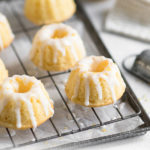
Beautiful! Back when I catered I would make mini Bundt cakes sometimes if desserts were required. I sure wish I’d had these silicone molds back then!
Thanks, Mimi! I love baking mini bundt cakes but the clean up is often quite painful 😉 These silicon molds are fantastic because they are so so easy to clean.
I have similar silicone molds and thought I would give this recipe a try. The cakes turned out perfectly. Lovely recipe.
That’s great that you enjoyed this recipe. Thanks for popping by!
These cakes are delicious! I used a non-stick mini bundt pan and used non-stick spray before adding the batter.